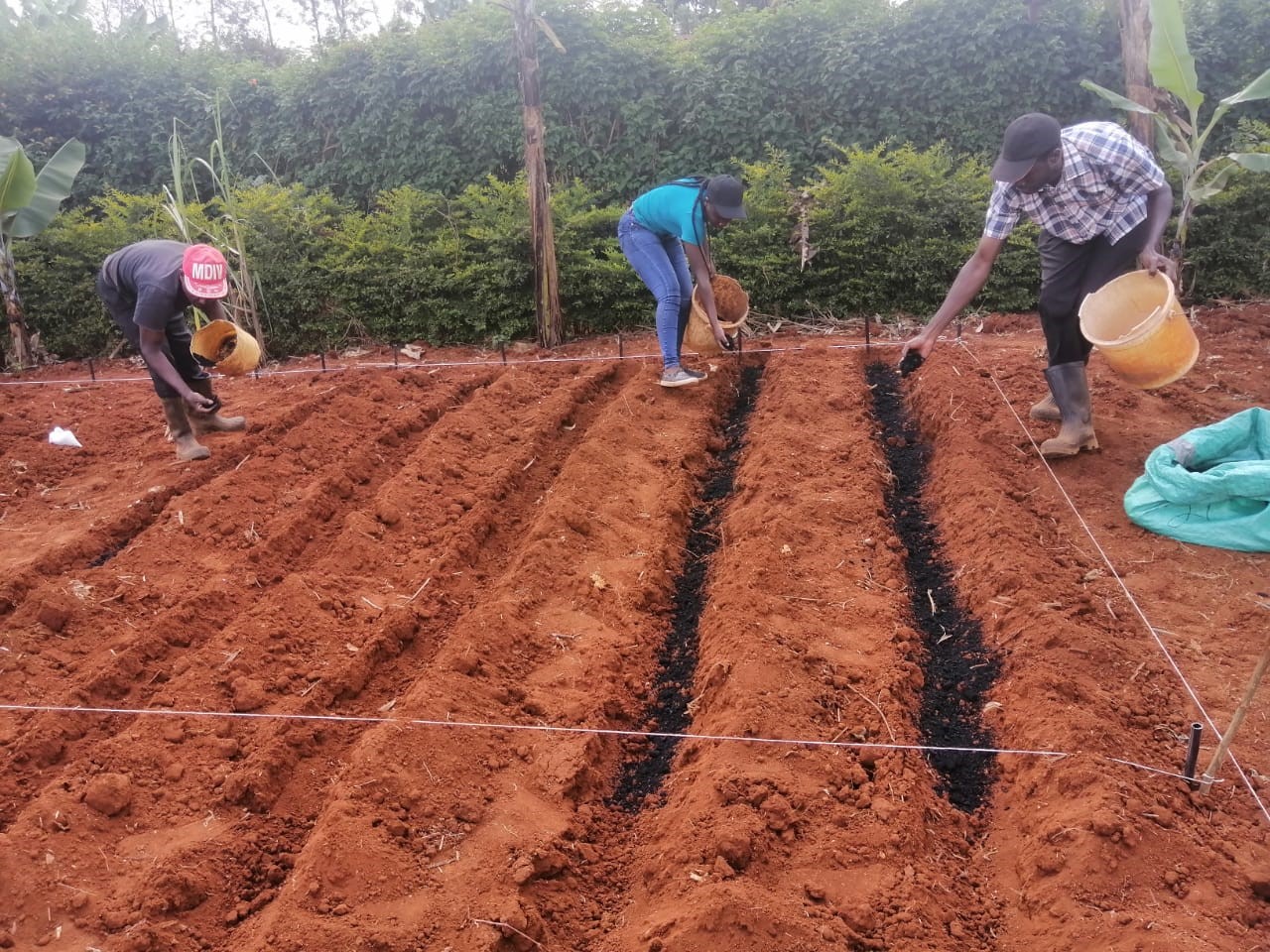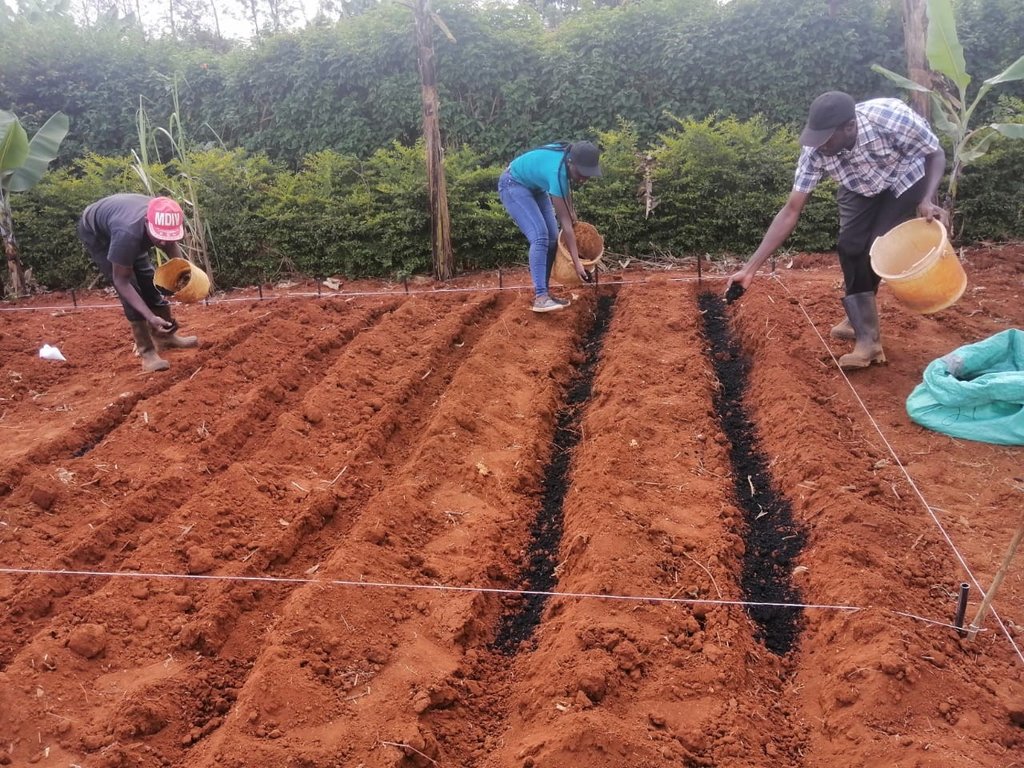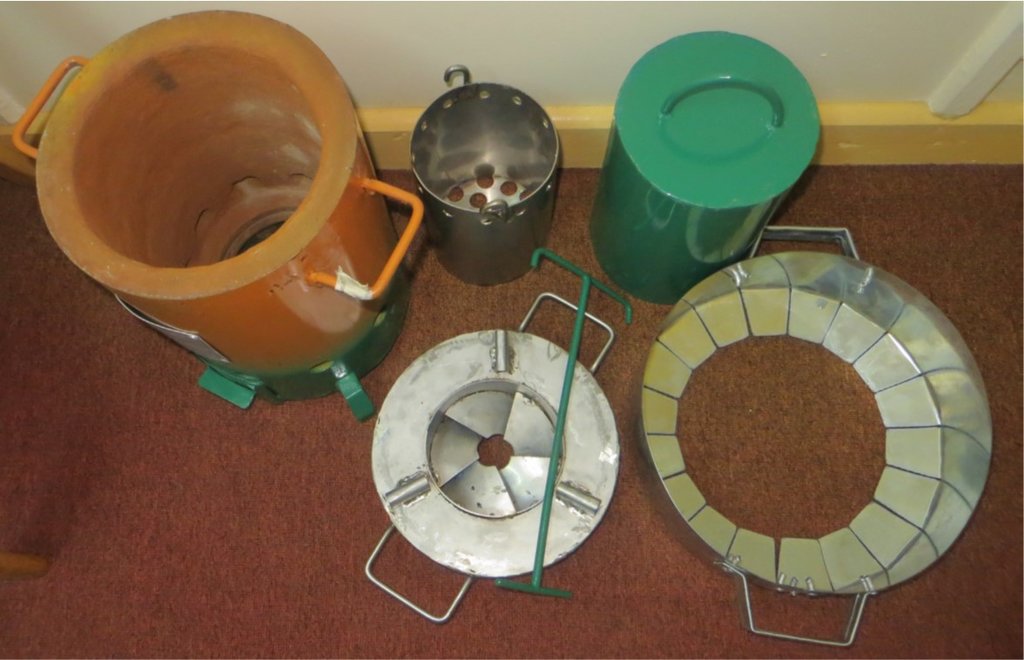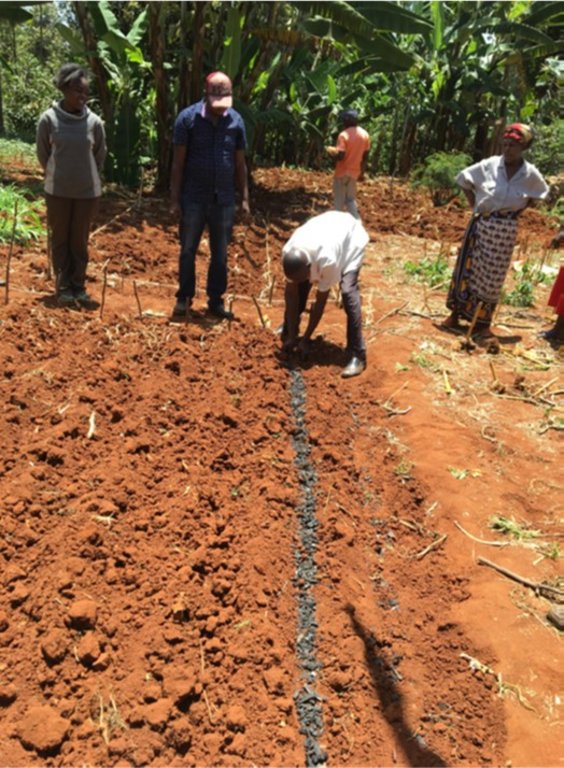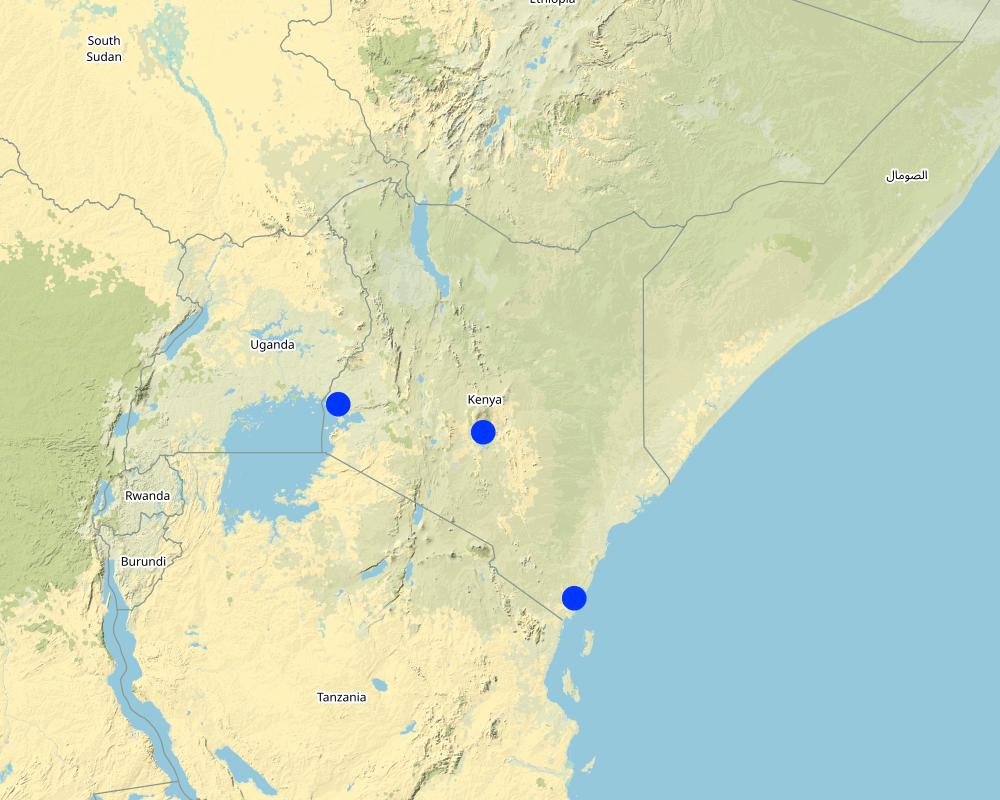Biochar application by smallholder farmers [Kenya]
- Creation:
- Update:
- Compiler: Niels Thevs
- Editor: Dries Roobroeck
- Reviewers: William Critchley, Rima Mekdaschi Studer
technologies_6349 - Kenya
View sections
Expand all Collapse all1. General information
1.2 Contact details of resource persons and institutions involved in the assessment and documentation of the Technology
Key resource person(s)
co-compiler:
co-compiler:
co-compiler:
Roebroock Dries
IITA
Kenya
1.3 Conditions regarding the use of data documented through WOCAT
The compiler and key resource person(s) accept the conditions regarding the use of data documented through WOCAT:
Yes
1.4 Declaration on sustainability of the described Technology
Is the Technology described here problematic with regard to land degradation, so that it cannot be declared a sustainable land management technology?
No
2. Description of the SLM Technology
2.1 Short description of the Technology
Definition of the Technology:
Application of biochar to soils in the tropics / sub-tropics improves their ability to store and supply nutrients and water for crop growth, thereby enhancing yields and food security. At the same time, biochar holds carbon in soils for extended time periods, which makes it an agricultural practice that contributes to climate change mitigation.
2.2 Detailed description of the Technology
Description:
Biochar is carbonised organic material that is produced through pyrolysis, that is thermal conversion under low or no oxygen. The biochar is used as an amendment to farmland for ameliorating soil properties. Owing to the great number of micropores and charges on biochar, its application to soil boosts water and nutrient storage, and their delivery to crops. Biochar also helps neutralise acidity in soils, replacing the need for lime. All these positive effects make it ideally suited for acid, nutrient-poor soils in tropical/ sub-tropical regions. Even at low rates of 1 or 2 tonnes per hectare, biochar significantly increases crop production. Biochar hardly decomposes in soils, causing positive effects to last for several years without repeat application. This also provides very stable carbon storage on farms which helps mitigate climate change. Its stability also allows farmers to gradually add biochar to the entire farm, thereby increasing their food self-sufficiency and incomes.
Biochar itself is not a fertilizer, but a soil rejuvenating agent. Therefore, farmers must apply essential nutrients through synthetic or organic inputs to reap the full yield potential and maintain soil fertility. Yet, when biochar is combined with fertilizers, about 40% - 70% nitrogen and phosphorus can be saved over multiple seasons while maintaining the same productivity. Biochar is a promising solution to address low response of crops to fertilizer addition in tropical soils and to alleviate the impact of input price hikes and supply disruptions.
In the study presented here, farmers produced biochar as a residue from small gasifier stoves during daily cooking. These systems are highly energy efficient and reduce the consumption of firewood while improving indoor air quality, which, alongside crop yield gains from biochar, is perceived positively by farmers. The specific design of gasifier stoves requires them to be well-packed with appropriately sized tree prunings or maize stems. For larger meals it requires a refill, which users find less convenient than their traditional open combustion fires. Life-cycle assessment shows that households significantly reduce greenhouse gas emissions with the gasifier stoves when biochar is applied to the farm. For the field trials with maize and kale in this study, farmers applied their usual rates of inorganic fertilizers, animal manure, or a combination of both. Results from this multi-locational participatory assessment showed that maize grain yield increased by 0.2 - 0.7 tonnes per hectare for every tonne of home-made biochar that was added to the field.
One household can produce 300 kg biochar per year by cooking on the gasifier stove. With this amount a biochar dosage of 1.5 t/ha can be realized on an area of 0.2 ha per year. If biochar is not spread evenly, but along seed rows, its effective dosage can be increased. As the gasifier stove can be operated for 2-3 years, it is assumed that the costs of 50 USD, which are needed to purchase one gasifier, are good to equip 1 ha of land with an amount of biochar that results in increased crop yields.
2.3 Photos of the Technology
General remarks regarding photos:
Both photographs were taken from the publication: Njenga M, Sundberg C, Gitau JK, Mahmoud Y, Röing de Nowina K, Mendum R and Karltun E 2020. Biochar stoves for socio-ecological resilience: Lessons from small-scale farms in rural Kenya. Policy Brief No 51. Nairobi, Kenya. World Agroforestry (ICRAF)
2.5 Country/ region/ locations where the Technology has been applied and which are covered by this assessment
Country:
Kenya
Region/ State/ Province:
Embu County, Kwale County, Siaya County
Specify the spread of the Technology:
- applied at specific points/ concentrated on a small area
Is/are the technology site(s) located in a permanently protected area?
No
Map
×2.6 Date of implementation
Indicate year of implementation:
2016
2.7 Introduction of the Technology
Specify how the Technology was introduced:
- during experiments/ research
Comments (type of project, etc.):
IITA (International Institute of Tropical Agriculture) started a long-term field trial in 2006, in which crop and soil properties were monitored following one initial biochar application of 100 t/ha. ICRAF investigated the charcoal value chain in Kenya and, among others, promoted cooking stoves which were more efficient than the traditionally used open fires. Those stoves run on pyrolysis, which provides heat for cooking and charcoal as a residual. That charcoal can be used for cooking so that the initial biomass is used more efficiently as an energy source. Or, alternatively, the residual charcoal is used as biochar to improve the farmers' soils.
This combination of cooking and biochar production and application to soils began in 2016 as participatory research.
3. Classification of the SLM Technology
3.1 Main purpose(s) of the Technology
- improve production
- adapt to climate change/ extremes and its impacts
- mitigate climate change and its impacts
- create beneficial economic impact
- create beneficial social impact
3.2 Current land use type(s) where the Technology is applied
Land use mixed within the same land unit:
No

Cropland
- Annual cropping
Annual cropping - Specify crops:
- cereals - maize
- vegetables - leafy vegetables (salads, cabbage, spinach, other)
Number of growing seasons per year:
- 2
Specify:
2 seasons in Embu and Siaya, 1 season in Kwale
Is intercropping practiced?
Yes
If yes, specify which crops are intercropped:
Part of the households intercrop maize with beans.
Is crop rotation practiced?
No
3.3 Has land use changed due to the implementation of the Technology?
Has land use changed due to the implementation of the Technology?
- No (Continue with question 3.4)

Cropland
- Annual cropping
Annual cropping - Specify crops:
- cereals - maize
Is intercropping practiced?
Yes
If yes, specify which crops are intercropped:
maize and beans
Is crop rotation practiced?
No
3.4 Water supply
Water supply for the land on which the Technology is applied:
- rainfed
3.5 SLM group to which the Technology belongs
- integrated soil fertility management
3.6 SLM measures comprising the Technology

agronomic measures
- A2: Organic matter/ soil fertility
3.7 Main types of land degradation addressed by the Technology

chemical soil deterioration
- Cn: fertility decline and reduced organic matter content (not caused by erosion)
- Ca: acidification

physical soil deterioration
- Pc: compaction
- Pi: soil sealing
Comments:
Biochar increases the cation exchange capacity of soils and enhances the plant availability of phosphorus so that it contributes to soil fertility. Biochar increases the soil pH so that it treats acidification of soils. In the field of soil physical properties, biochar decreases the bulk density of soils and adds pore space to soils so that the infiltration into the soil and the usable field capacity of soils are increased. In this specific case, soil sealing and compaction do not play a role, but biochar can address those soil degradation issues.
3.8 Prevention, reduction, or restoration of land degradation
Specify the goal of the Technology with regard to land degradation:
- reduce land degradation
- restore/ rehabilitate severely degraded land
4. Technical specifications, implementation activities, inputs, and costs
4.2 General information regarding the calculation of inputs and costs
Specify how costs and inputs were calculated:
- per Technology unit
Specify unit:
one gasifier cooking stove and the resulting amount of biochar
Specify currency used for cost calculations:
- USD
4.3 Establishment activities
| Activity | Timing (season) | |
|---|---|---|
| 1. | Biochar production | Year-round while using the gasifier cooking stove. |
| 2. | Mixing biochar into the soil | During the normal time of field preparation for and planting of the next crop |
| 3. | Proceed with normal cropping activities |
Comments:
This SLM technique adds biochar to the ongoing cropping activities. So, the choice of crops, soil preparation, planting, inputs, and harvest do not change after biochar application. The biochar is sourced from so-called gasifier cooking stoves, which are stoves that perform through pyrolysis. The excess energy of that pyrolysis is used for cooking, while the residual char is applied as biochar to the farmers' field. Char (biochar) is produced during every cooking activity, collected, and finally applied. Most household in the project regions use open three-stone fires for cooking followed by charcoal. Adoption of the gasifier stoves is a shift away from the open fires and charcoal.
4.4 Costs and inputs needed for establishment
| Specify input | Unit | Quantity | Costs per Unit | Total costs per input | % of costs borne by land users | |
|---|---|---|---|---|---|---|
| Labour | gasifier cooking stove | 1.0 | 50.0 | 50.0 | ||
| Total costs for establishment of the Technology | 50.0 | |||||
| Total costs for establishment of the Technology in USD | 50.0 | |||||
Comments:
As costs we only listed the 50 USD per gasifier cooking stove. As the other farm operations do not change, no further costs for plant materials or fertilizers or other were listed, because those inputs do not change solely due to the use of biochar from the gasifier stoves.
One household can produce 300 kg biochar per year by cooking on the gasifier stove. With this amount a biochar dosage of 1.5 t/ha can be realized on an area of 0.2 ha per year. If biochar is not spread evenly, but along seed rows, its effective dosage can be increased. As the gasifier stove can be operated for 2-3 years, it is assumed that the costs of 50 USD are good to equip 1 ha of land with an amount of biochar that results in increased crop yields.
4.5 Maintenance/ recurrent activities
| Activity | Timing/ frequency | |
|---|---|---|
| 1. | Replace the gasifier cooking stove | every three years |
Comments:
Once biochar has been applied into a given soil, it sits there in the soil and does not require further maintenance. The farming activities and their associated labor remain unchanged compared to the the time before biochar application.
4.6 Costs and inputs needed for maintenance/ recurrent activities (per year)
| Specify input | Unit | Quantity | Costs per Unit | Total costs per input | % of costs borne by land users | |
|---|---|---|---|---|---|---|
| Equipment | gasifier cooking stove | 1 | 0.33 | 50.0 | 16.5 | 100.0 |
| Total costs for maintenance of the Technology | 16.5 | |||||
| Total costs for maintenance of the Technology in USD | 16.5 | |||||
Comments:
The depreciation of the gasifier cooking stove and the need to replace it every three years is included here unde rrecurrent costs.
4.7 Most important factors affecting the costs
Describe the most determinate factors affecting the costs:
Purchase price of the gasifier stove. Opportunity cost for collection and pre-processing of tree prunings and crop residues for the stove.
5. Natural and human environment
5.1 Climate
Annual rainfall
- < 250 mm
- 251-500 mm
- 501-750 mm
- 751-1,000 mm
- 1,001-1,500 mm
- 1,501-2,000 mm
- 2,001-3,000 mm
- 3,001-4,000 mm
- > 4,000 mm
Specifications/ comments on rainfall:
Embu: 1200 mm, Siaya: 1350 mm, Kwale 1050 mm
Agro-climatic zone
- sub-humid
5.2 Topography
Slopes on average:
- flat (0-2%)
- gentle (3-5%)
- moderate (6-10%)
- rolling (11-15%)
- hilly (16-30%)
- steep (31-60%)
- very steep (>60%)
Landforms:
- plateau/plains
- ridges
- mountain slopes
- hill slopes
- footslopes
- valley floors
Altitudinal zone:
- 0-100 m a.s.l.
- 101-500 m a.s.l.
- 501-1,000 m a.s.l.
- 1,001-1,500 m a.s.l.
- 1,501-2,000 m a.s.l.
- 2,001-2,500 m a.s.l.
- 2,501-3,000 m a.s.l.
- 3,001-4,000 m a.s.l.
- > 4,000 m a.s.l.
Indicate if the Technology is specifically applied in:
- not relevant
Comments and further specifications on topography:
Kwale: 328 m a.s.l.
Embu: 1350 m a.s.l.
5.3 Soils
Soil depth on average:
- very shallow (0-20 cm)
- shallow (21-50 cm)
- moderately deep (51-80 cm)
- deep (81-120 cm)
- very deep (> 120 cm)
Soil texture (topsoil):
- medium (loamy, silty)
Soil texture (> 20 cm below surface):
- medium (loamy, silty)
Topsoil organic matter:
- medium (1-3%)
If available, attach full soil description or specify the available information, e.g. soil type, soil PH/ acidity, Cation Exchange Capacity, nitrogen, salinity etc.
The following information are available for two field plots out of the three counties:
Embu County: pH(H2O) - 5.01, SOC - 2.01%, sand - 21%, clay - 43.5%
Siaya County: pH(H2O) - 5.25, SOC - 1.56%, sand - 22.4%, clay - 60.1%
5.4 Water availability and quality
Availability of surface water:
good
Water quality (untreated):
poor drinking water (treatment required)
5.6 Characteristics of land users applying the Technology
Sedentary or nomadic:
- Sedentary
Market orientation of production system:
- subsistence (self-supply)
Off-farm income:
- 10-50% of all income
Relative level of wealth:
- poor
Individuals or groups:
- individual/ household
Level of mechanization:
- manual work
Gender:
- women
- men
Indicate other relevant characteristics of the land users:
Women and children operate the gasifier stove and therefore produce the biochar. In the field it is mainly men who mix the biochar into the soil and perform other farm operations.
5.7 Average area of land used by land users applying the Technology
- < 0.5 ha
- 0.5-1 ha
- 1-2 ha
- 2-5 ha
- 5-15 ha
- 15-50 ha
- 50-100 ha
- 100-500 ha
- 500-1,000 ha
- 1,000-10,000 ha
- > 10,000 ha
Is this considered small-, medium- or large-scale (referring to local context)?
- small-scale
Comments:
0.5 - 2 ha
5.8 Land ownership, land use rights, and water use rights
Land ownership:
- individual, not titled
- individual, titled
Land use rights:
- individual
Water use rights:
- open access (unorganized)
Are land use rights based on a traditional legal system?
Yes
5.9 Access to services and infrastructure
health:
- poor
- moderate
- good
education:
- poor
- moderate
- good
technical assistance:
- poor
- moderate
- good
employment (e.g. off-farm):
- poor
- moderate
- good
markets:
- poor
- moderate
- good
energy:
- poor
- moderate
- good
roads and transport:
- poor
- moderate
- good
drinking water and sanitation:
- poor
- moderate
- good
financial services:
- poor
- moderate
- good
6. Impacts and concluding statements
6.1 On-site impacts the Technology has shown
Socio-economic impacts
Production
crop production
Quantity before SLM:
0,9 Mg/ha
Quantity after SLM:
4.4 Mg/ha
Comments/ specify:
- Range of maize: from 0,9 Mg/ha (control) to 4.4 Mg/ha (biochar plot) and average increase of 33% in kale yields (on 68% of the farms) in experiment where farmers used their own biochar.
- in longterm experiment with higher amounts of biochar a yield increase of 84% was observed
-
Income and costs
diversity of income sources
Comments/ specify:
20-40% of firewood could be saved by using the biochar gasifiers instead of traditional cooking stoves. This reduces costs and work load for households.
Ecological impacts
Climate and disaster risk reduction
emission of carbon and greenhouse gases
Comments/ specify:
54 to 100% plus net carbon sequestration.
6.2 Off-site impacts the Technology has shown
impact of greenhouse gases
Comments/ specify:
Due to reduced demand for fuel wood, this SLM technology reduces forest degradation and associated greenhouse gas emissions.
6.4 Cost-benefit analysis
How do the benefits compare with the establishment costs (from land users’ perspective)?
Short-term returns:
positive
Long-term returns:
positive
How do the benefits compare with the maintenance/ recurrent costs (from land users' perspective)?
Short-term returns:
positive
Long-term returns:
positive
Comments:
The main benefits from this SLM technology from the land users' perspective are increased crop yields, reduced need to collect fuel wood, and improved indoor ambient air quality. The latter two benefits materialize immediately, onec the gasifier is used. The crop yields increase during the season that follows the biochar application, which is a short-term benefit. These benefits justify the establishment costs, which in fact are the costs to purchase the gasifier.
On a long-term perspective, the effect to improve the soil, which leads to crop yield increases, remains, because biochar is stable in soils ove rlong time periods. Particularly positive is that there are no maintenence costs to keep the biochar in the soil.
6.5 Adoption of the Technology
- single cases/ experimental
Of all those who have adopted the Technology, how many did so spontaneously, i.e. without receiving any material incentives/ payments?
- 0-10%
6.6 Adaptation
Has the Technology been modified recently to adapt to changing conditions?
No
6.7 Strengths/ advantages/ opportunities of the Technology
| Strengths/ advantages/ opportunities in the land user’s view |
|---|
| Most land users stated to have observed positive impacts on soil health and improvement of soil fertility. Additionally, about 25% of the land users specifically mentioned that the moisture retention in the soil improved after biochar application. Some land users experienced lower costs for fertilizers. |
|
Most land users found the small top-lit updraft cooking stoves are easy to use, though being more suitable for food with short cooking time. All land users stated that the gasifier cooking stoves were cleaner than the traditional open fires and charcoal stoves, since the gasifiers produced less smoke, less soot, and fewer ashes. Some land users responded even that the gasifiers were less harmful to cooking utensils and food tasted better (less smoky). The gasifier stove was preferred by land users because it takes less fuel and therefore saves time to collect fire wood and household expenditures. This was particularly viewed positively by women. The residual char also can be used as an energy source. Some land users saw sales of charcoal as potential additional income. |
| In total, the package of using gasifier stoves for cooking and applying the residual biochar to soils was seen as beneficial by most land users, because it saved costs and efforts on the side of cooking and increased crop yields and income. |
| Strengths/ advantages/ opportunities in the compiler’s or other key resource person’s view |
|---|
|
Biochar improves soil properties which intensifies crop production. Even a small amount of biochar added to the soil has a long-lasting positive effect on yields. The effect of a one-time biochar application lasts for decades. Therefore, if soils are enriched with biochar by repeatedly adding low quantities, its benefits to land users accumulate over time. Biochar increases the cation exchange capacity, pH, and phosphorus availability of soils, which are key constraints to in many farming systems across tropical Africa. Non-responsive soils are turned into soils that respond to fertilizer application. |
6.8 Weaknesses/ disadvantages/ risks of the Technology and ways of overcoming them
| Weaknesses/ disadvantages/ risks in the land user’s view | How can they be overcome? |
|---|---|
| Half of the respondents stated the production of biochar was time consuming due to the process of cutting the feedstock in suitable sizes, as needed for the gasifier stove. | Chopped firewood for the gasifier could become a source of income for youth. |
| Weaknesses/ disadvantages/ risks in the compiler’s or other key resource person’s view | How can they be overcome? |
|---|---|
| Gasifiers may emit more methane than technologically more advanced pyrolysis units. |
Improve the gasifier utility with a shift to the latest mobile or decentralized technologies that produce syngas, green hydrogen or electricity that can be used for cooking. |
| Deploying gasifier and biochar at large scale without regulations poses a risk of unsustainable rates of tree clearing and residue removal. | Follow rules such as EBC and only use on-farm or residual biomass. |
7. References and links
7.1 Methods/ sources of information
- field visits, field surveys
Field surveys took place within different research works, which were published in peer-reviewed papers.
- interviews with land users
Interviews with land users took place within different research works, which were published in peer-reviewed papers.
- compilation from reports and other existing documentation
The information was compiled from peer-reviewed papers and exchange with the authors of those papers.
Comments:
The study was conducted between 2013 and 2019 and results of different work streams were published in a number of peer-reviewed papers.
7.2 References to available publications
Title, author, year, ISBN:
Biochar from cooking stoves reduces greenhouse gas emissions from smallholder farms in Africa; Sundberg et al., 2020
Available from where? Costs?
https://link.springer.com/article/10.1007/s11027-020-09920-7, open access
Title, author, year, ISBN:
Use of Biochar-Producing Gasifier Cookstove Improves Energy Use Efficiency and Indoor Air Quality in Rural Households; Gitau et al., 2019
Available from where? Costs?
https://www.mdpi.com/1996-1073/12/22/4285, open access
Title, author, year, ISBN:
Implications on Livelihoods and the Environment of Uptake of Gasifier Cook Stoves among Kenya’s Rural Households; Gitau et al., 2019
Available from where? Costs?
https://www.mdpi.com/2076-3417/9/6/1205/pdf, open access
Title, author, year, ISBN:
Factors influencing the adoption of biochar-producing gasifier cookstoves by households in rural Kenya; Gitau et al., 2019
Available from where? Costs?
https://www.sciencedirect.com/science/article/pii/S0973082618308913, open access
Title, author, year, ISBN:
Soils, sinks, and smallholder farmers: Examining the benefits of biochar energy transitions in Kenya; Mahmood et al., 2021
Available from where? Costs?
https://reader.elsevier.com/reader/sd/pii/S2214629621001262?token=D446F30FC8FDAEC80F73AE31BBFEA69E754E2F9EB21A9605CC6D04A2FE0FCD39182848F88AC6D17BF7D12B8EEED7BD9E&originRegion=eu-west-1&originCreation=20210415190025, open access
Title, author, year, ISBN:
Gasifier as a cleaner cooking system in rural Kenya; Njenga et al., 2016
Available from where? Costs?
https://www.sciencedirect.com/science/article/abs/pii/S0959652616000743?via%3Dihub, access at no costs through limited number of institutions
Title, author, year, ISBN:
Biochar addition persistently increased soil fertility and yields in maizesoybean rotations over 10 years in sub-humid regions of Kenya; Kätterer et al., 2019
Available from where? Costs?
https://www.sciencedirect.com/science/article/pii/S0378429018318938?via%3Dihub, open access
Title, author, year, ISBN:
sMaize grain yield responses to realistic biochar application rates on smallholder farms in Kenya, Kätterer et al., 2022
Available from where? Costs?
https://link.springer.com/article/10.1007/s13593-022-00793-5, open access
7.3 Links to relevant online information
Title/ description:
Biochar stoves for socio-ecological resilience: Lessons from small-scale farms in rural Kenya / Report by ICRAF
URL:
http://apps.worldagroforestry.org/downloads/Publications/PDFS/PB20040.pdf
Links and modules
Expand all Collapse allLinks
No links
Modules
No modules


